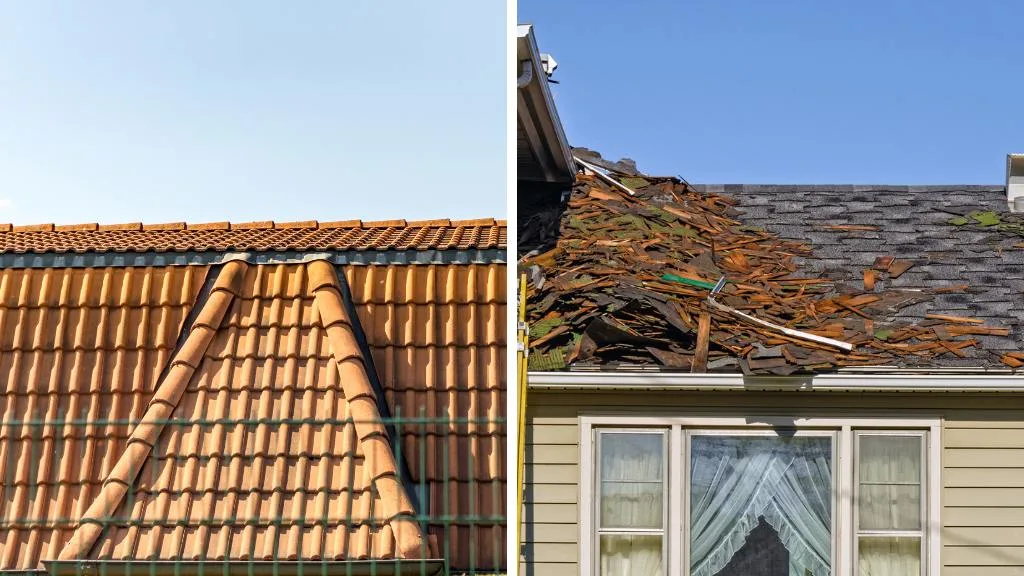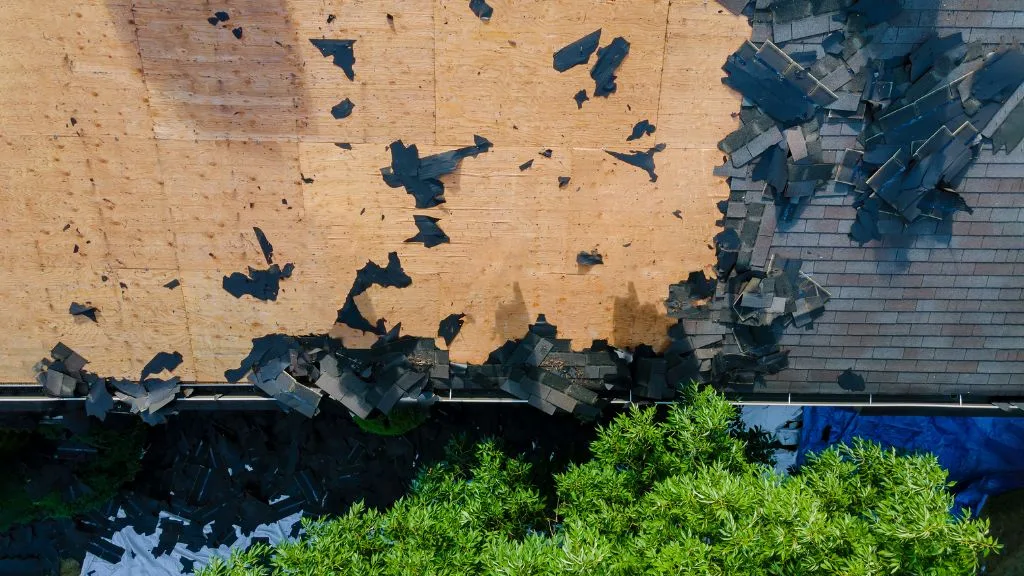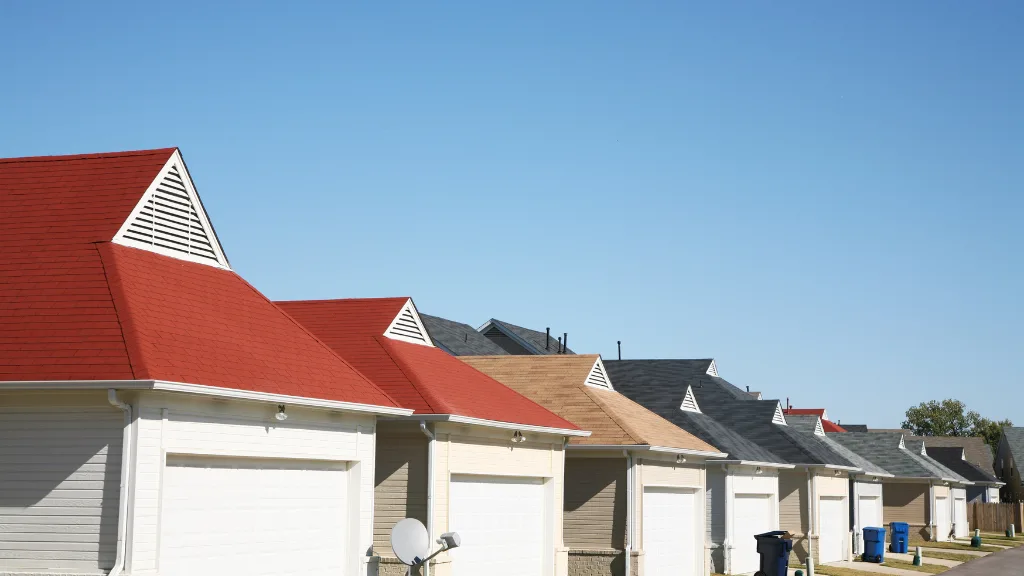
It’s common knowledge that repairing your roof is a costly investment. However, what you may not know is the difference between an overlay and tear off.
This blog post will help you decide which one to choose for your home or business by discussing what they are and how they work.
What is a Roof Overlay?
A roof overlay is a less extreme option that involves laying new shingles on top of the old ones. It will not require removing any existing covering, but it does come with its own set of challenges.
First and foremost, you must consider your budget since overlays are more affordable than tear offs.
If you have an adequate budget to cover the costs of materials and labor, then this may be an ideal solution.
However, one of the most significant downsides is that you will still need to replace your roof at some point in time because overlaying does not actually prolong its life expectancy – it merely delays the inevitable wear and tear.
What is a Tear Off?
A tear off is a much more extreme solution that involves removing all existing layers of roofing down to the plywood deck.
This method will give you immediate results, but it can also be one of the most expensive options on the market – particularly if you have a larger home or commercial building with shingles made from high-grade materials.
However, one of the top benefits is that it can double or even triple your home’s lifespan. With a tear off , you will be able to benefit from an entirely new roof – meaning no repairs for years!
Advantages of a Roof Overlay
It is not uncommon for roofs to need replacement after ten years.
Roofs typically last 15-20 years depending on the type of roofing material and the climate (how expensive your roof is to replace will be defined by how long it takes for you to recoup that cost by reducing your energy bills).
The most common reason a roof needs replaced is because it is leaking.
Repairing a roof usually involves a lot of time and materials, as well as a huge mess that can take months to fix.
Some roofs are not worth repairing and need to be completely replaced.
If your roofing material is no longer available or you just want to use something different, there is an alternative to complete replacement – installing a new roof overlay.
A roofing overlay refers to the process of covering the existing roof with additional layers of roofing material, such as shingles or metal panels.
There are several benefits to considering this type of project instead of total replacement:
1) It is less expensive than replacing an entire roof – With a full roof replacement, you have to remove the old roof and purchase all new materials.
An overlay project involves adding new layers on top of the existing material, so there is no need to purchase new materials.
This can save you up to 50% compared with a full roof replacement.
2) It is much less disruptive than installing an entirely new roof – Replacing an entire roof will require removal of the old one, so any plants or structures around your home will need to be moved.
This also requires a lot more time and mess all over your yard or landscaping. An overlay can usually be installed in a few hours with minimal disruption to anything around the house.
3) It is faster than installing an entirely new roof – It can take up to two weeks, depending on the weather conditions, for a roofing crew to remove your old roof and install an entire new one.
An overlay will only take one or two days.
4) You don’t need a building permit – Depending on the size of your project, you may not need a township building permit.
If you’re only adding an extra layer of shingles to your roof, most townships will not require you to get a permit.
5) An overlay won’t change the appearance of your roof – Overlays can come in any color and style that you want and use the same materials as your original home.
You won’t need to worry about your roof sticking out like a sore thumb if it is the same color as all of your neighbors’ roofs.

Disadvantages of a Roof Overlay
Roof overlays are the quickest, easiest, and least expensive way to repair a roof. But there are disadvantages to using roof overlays instead of full tear offs or complete roof repairs.
There are several problems that may be caused by overlaying your existing shingled roof with another layer of dimensional asphalt shingles.
1) An overlay roof will trap rain, snow and ice beneath it. This can lead to ice damming and water leaks into the home’s ceilings and walls.
The most prominent of these is that if you have a skylight that has been covered with an overlay, this potential leak can ruin your ceilings, drywall, insulation, and everything else that happens to be in its path.
2) The second issue with an overlay is that it traps moisture between the two layers of roofing material, which can lead to premature roof sheathing rot and/or deck deterioration.
3) A third problem with overlays is that they are not intended for steep roofs. When asphalt shingles are applied to a steep roof, they easily peel and float.
4) A fourth issue with overlays is that your home’s ventilation system is blocked by the shingles on top, which can cause moisture and mildew problems inside the home.
Water running over the edge of the roof carries noxious materials from algae, moss, mold, and mildew that are blocked by the overlay.
5) The final issue is that an overlay has a short lifespan. This short lifespan can also lead to ice damming problems when your roof does not last long enough for your climate’s freeze/thaw cycles.
Therefore, it is strongly recommended to use full tear offs when repairing a roof if you don’t like the above drawbacks.
Advantages of a Tear Off Roof
A tear off roof is a method of removing all old shingles and debris from your house.
This process can be compared to the removal of wallpaper, where complete removal of the surface may be necessary before painting or other finishes are applied.
A tear off roof is typically done in preparation for another material such as tile or metal. It has a number of advantages, which will be discussed in greater detail below.
1) The biggest advantage is the speed with which a tear off roof can be done. It can take as little as a day to strip the surfaces, resulting in a smooth surface free from old shingles and debris.
2) A tear off roof also allows for an easier installation of certain materials. Tile roofs are very difficult to install when there are remnants of the previous roofing material resting on top of the frame.
3) A tear off roof leaves a clean surface, making it much easier to complete installation in a timely manner.
4) There are many options for what you can replace your old shingles with once the tear off is done.
You may want to try a metal roof, which would be much easier to install over a fresh and clean surface. Some homeowners choose to try tile roofs, which are also easier to install when the surface has been stripped of all old shingles.
5) A tear off roof can prevent leaks that may affect your home or damage its structure.
When there is debris covering the entire surface of your house, it will cause problems with runoff. This could lead to a muddy area near your home or even a small landslide, which could do a lot of damage.
6) Many insurance companies offer discounts for tear off roofing services.
If you have been paying out of pocket to get it done, you will be able to save money by taking advantage of these types of offers.
7) You can also save money on energy bills after a tear off roof.
The older the material, the less effective it will be as insulation for your home. A fresh and clean surface will provide more benefits than an old one.
While re-roofing is not preferable to many homeowners, it is much better than having a leaky roof, as well as the other problems associated with debris and an older shingle covering.

Disadvantages of a Tear Off Roof
Roofs are often replaced to improve the look of a home, because they may start leaking or be deteriorated to the point where it is not structurally sound.
Before selecting a new roof type for your home, consider whether you may want or need to remove the existing roof if it hasn’t already been removed prior to replacement.
There are several disadvantages of a tear off roof that you should consider before tearing off an existing roof.
1) If the existing roof is not in good shape, but will last a few more years, it may be better to keep it rather than tear it off and start over.
A new roof will cost much more money and may not actually last as long as the existing roof.
2) If you choose a new type of roofing material, you may be stuck with a particular style for many, many years.
If you have a modern home and want to change the look, this might not be possible by adding another layer of shingles over your old ones; they would need to be removed and replaced with a new type of shingle.
3) Roof removal is a messy job that leaves the yard in a state of disarray for some time until the new roof can be installed.
This may or may not affect your resale value, but it might look bad from the street for several months if you have a large roof.
4) You will have to pay someone to remove the old roof and dispose of it responsibly.
This is a cost you might not expect, but must factor into your budget when planning a new roof installation.
5) A tear off roof poses a greater risk of damage during a storm than a properly maintained existing structure with no added weight.
If you are located in an area where tornadoes, hurricanes, or other serious weather events are possible, this might be a concern.
Go with the new roof right away rather than waiting for the old roof to fail before starting over.
6) An old roof may contain lead-based shingles.
Lead is highly toxic and can pose a serious hazard if it is not handled and disposed of properly. It is illegal to dump lead-based products in the trash and hauling companies will refuse to pick up this type of waste because of liability issues.
7) The new roof you install may need repairs after the old one is removed, so it pays to get an estimate and an exact quote for your new roof before it is installed.
You may want to consider the cost of these repairs as part of the total cost, or you may use them as leverage to negotiate a better deal with your contractor.
8) It’s not unusual to see clear-cutting taking place when someone tears off their roof and starts over. This is very visible and will look bad for your home.
9) Removing just one layer of shingles may not solve the underlying problem with leaks.
The roof may continue to leak months or years after it is replaced, especially if you tear off both layers before starting over.
A tear off roof may not be a good idea because the only thing you are doing is removing an existing structure and putting another one in its place.
Consider the environmental impact before you decide to remove your old roof. However, if you want to really do a reroofing process. Then you can go for it.
Which Should You Choose?
The best way to decide which option is right for you and your property is to consult with a roofing contractor.
They can assess your home or business and provide you with all the details about each option, including how it will impact your property’s resale value and any necessary repairs that will need to be completed after their work is complete.
If you are concerned about the cost of your roofing project, then an overlay may be best for your situation.
It will increase curb appeal and reduce any leakage problems until it’s time to replace your entire shingle covering with a tear off .
However, if prolonging the life expectancy is one of your top goals , then talk with a roofing contractor about the benefits of a tear off.
You will be able to save money in the long-term by having your property’s roof replaced from top to bottom.
Bottomline, you will need to take into account your budget and what you want the final result of the project to be.

